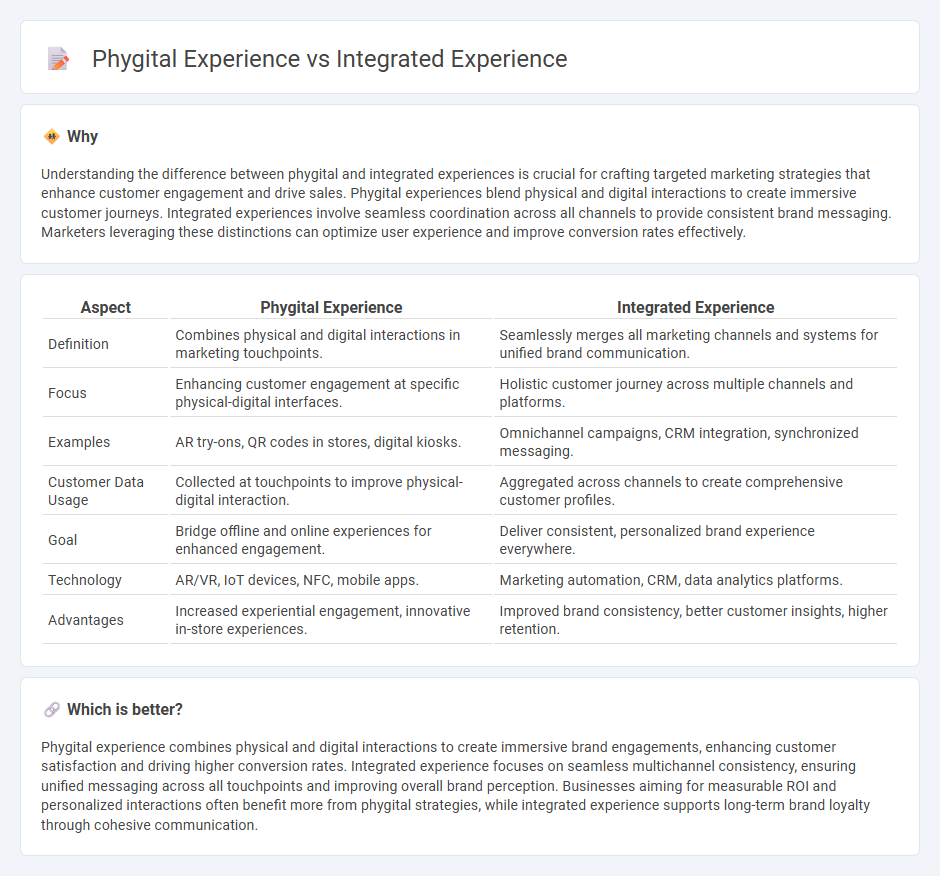
Phygital experience blends physical and digital interactions to create seamless customer journeys that enhance engagement and satisfaction. Integrated experience focuses on unifying all channels, touchpoints, and data to deliver consistent brand messaging and personalized interactions. Explore how these strategies reshape marketing effectiveness and customer loyalty.
Why it is important
Understanding the difference between phygital and integrated experiences is crucial for crafting targeted marketing strategies that enhance customer engagement and drive sales. Phygital experiences blend physical and digital interactions to create immersive customer journeys. Integrated experiences involve seamless coordination across all channels to provide consistent brand messaging. Marketers leveraging these distinctions can optimize user experience and improve conversion rates effectively.
Comparison Table
| Aspect | Phygital Experience | Integrated Experience |
|---|---|---|
| Definition | Combines physical and digital interactions in marketing touchpoints. | Seamlessly merges all marketing channels and systems for unified brand communication. |
| Focus | Enhancing customer engagement at specific physical-digital interfaces. | Holistic customer journey across multiple channels and platforms. |
| Examples | AR try-ons, QR codes in stores, digital kiosks. | Omnichannel campaigns, CRM integration, synchronized messaging. |
| Customer Data Usage | Collected at touchpoints to improve physical-digital interaction. | Aggregated across channels to create comprehensive customer profiles. |
| Goal | Bridge offline and online experiences for enhanced engagement. | Deliver consistent, personalized brand experience everywhere. |
| Technology | AR/VR, IoT devices, NFC, mobile apps. | Marketing automation, CRM, data analytics platforms. |
| Advantages | Increased experiential engagement, innovative in-store experiences. | Improved brand consistency, better customer insights, higher retention. |
Which is better?
Phygital experience combines physical and digital interactions to create immersive brand engagements, enhancing customer satisfaction and driving higher conversion rates. Integrated experience focuses on seamless multichannel consistency, ensuring unified messaging across all touchpoints and improving overall brand perception. Businesses aiming for measurable ROI and personalized interactions often benefit more from phygital strategies, while integrated experience supports long-term brand loyalty through cohesive communication.
Connection
Phygital experience merges physical and digital marketing channels to create seamless customer interactions, driving higher engagement and brand loyalty. Integrated experience ensures all touchpoints, both online and offline, function cohesively to provide consistent messaging and personalized journeys. Together, phygital and integrated experiences enhance customer satisfaction by unifying data and communication across platforms.
Key Terms
Omnichannel
Omnichannel strategies create seamless customer journeys by integrating physical and digital touchpoints into a unified experience, whereas phygital experience specifically blends physical and digital interactions to enhance engagement in select moments. Integrated experiences emphasize consistency across channels including in-store, online, and mobile apps, ensuring brand coherence and data-driven personalization. Explore how businesses leverage omnichannel frameworks to deliver superior phygital experiences and drive customer loyalty.
Customer Journey
Integrated experience seamlessly blends digital and physical touchpoints throughout the customer journey, creating a unified and consistent brand interaction that enhances engagement and satisfaction. Phygital experience emphasizes the fusion of physical and digital environments, leveraging technology like AR, VR, and IoT to deliver immersive, interactive moments that bridge offline and online channels. Explore how each approach transforms customer journey strategies and drives business growth.
Touchpoints
Integrated experience seamlessly connects digital and physical touchpoints, ensuring consistent brand interaction across channels like mobile apps, in-store displays, and social media platforms. Phygital experience blends physical presence with digital enhancements such as augmented reality or interactive kiosks, enriching customer engagement at specific points. Discover how optimizing these touchpoints elevates consumer satisfaction and drives loyalty.
Source and External Links
What Are Integrated Experiences? - Boomi - An integrated experience involves modernizing data, connectivity, and user engagement to create seamless, responsive interactions that make organizations more intelligent, agile, and efficient by providing trusted data, pervasive connectivity, and frictionless user touchpoints across devices and platforms.
Integrative Experience : Faculty Senate - UMass Amherst - Integrative Experience courses are upper-division academic courses designed to encourage students to connect and reflect on learning across their curriculum, promoting integrative thinking and preparing them for life beyond university through structured reflection and synthesis.
Understanding the Importance of Integrated Experience - The Integrated Experience refers to how individual behavior impacts others' behavior, emphasizing the control of one's own actions to positively influence interactions and reduce stress or conflict, as taught in crisis prevention training.
 dowidth.com
dowidth.com